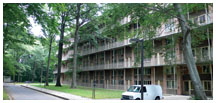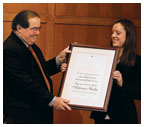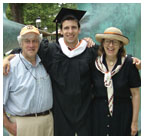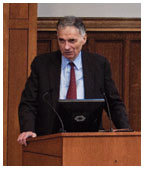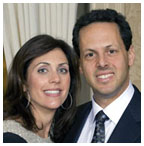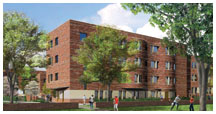
|
April 2, 2008: Notebook
The end’s in sight for Butler apartments
Project Inside helps prison inmates earn degrees
Student’s proof ends 60 years of math puzzling
Pair called civil rights ‘heroes’
Targeting alumni who aren’t connected to Princeton
|
The end’s in sight for Butler apartments
About 400 graduate students live in the barracks-style Butler units, built in 1946–47 as temporary housing.
When the Butler apartments were built on the old polo field in 1946–47 to quickly provide student housing for newly returned married veterans, the intent was to provide additional housing in short order and to demolish the barracks-style units within five years.
Six decades later the 304 apartments of the Butler tract still house about 400 graduate students — but the clock is ticking. By June 2012 the Butler apartments will be vacated and subsequently torn down as part of a plan, estimated to cost more than $100 million, to upgrade housing that the University provides for graduate students, faculty, and staff.
“This is a major step toward continuing to fulfill our commitment to house a major portion of our graduate students in a way that helps build community and will keep as many as possible close to campus,” said William Russel, dean of the Graduate School.
The University proposes to move grad students into apartments that are currently occupied by faculty and staff. In turn, new apartments, town houses, and single-family homes for faculty and staff are planned for the 33-acre Butler tract, and new faculty/staff apartments are planned just west of Dean Mathey Court at Harrison Street and Faculty Road.
Here are the major elements of the plan, as outlined in a letter to grad students by Director of Housing Andrew Kane:
• In 2010–11 the 96-unit Hibben apartment complex, which overlooks Lake Carnegie and has about 45 percent grad students and 55 percent faculty and staff, will be closed for major renovations. The building will reopen in the fall of 2011 solely for grad students. The new rental units adjacent to Dean Mathey Court also are expected to be constructed in this time period.
• In 2011–12 the 96-unit Magie apartment building, adjacent to Hibben and with a similar percentage of grad students and faculty/staff, will be shut down for renovations. It will reopen in the fall of 2012.
• The 154-unit Stanworth apartments, located several blocks north of Nassau Street off Bayard Lane, gradually will change from faculty/staff to grad student housing between 2011 and 2014.
• The Butler apartments are to be demolished in 2012 and replaced by a variety of housing for faculty and staff. Tentative plans call for about 40 single-family homes, 70 town houses, and 100 apartments.
In response to the plan, some grad students distributed a flier with the message: “Save Butler! They’re coming to take our homes! 60 years of beautiful tradition — gone!” The Graduate Student Government Executive Committee said the current amount of University housing is “not sufficient,” given the challenges of finding affordable off-campus apartments.
In addition, graduate students have called for their own social space on campus as housing becomes more dispersed. Russel said that concern was “not without merit,” but that it is unclear how the reopening of Campus Club this fall may help address that need.
The University is committed to providing housing for about 70 percent
of all graduate students who do not have Dissertation Completion Enrollment
(DCE) status, Russel said, although the current percentage — boosted
by grad students who live in the new four-year undergraduate colleges
— is closer to 78 percent, a record number. Univer-sity housing
is guaranteed to every first-year grad student who requests it. In subsequent
years grad students participate in a room-draw system, and demand exceeds
the supply. ![]()
By W.R.O.
MORE ON THE WEB, click here: Room draw, a stressful time for grad students.

Documenting
the ‘wealth gap’
Survey: Lower-income status keeps some students from full Princeton
experience
Students from lower-income backgrounds are twice as likely as wealthy students to report that they have failed to purchase course materials on at least one occasion, and are more likely to abstain from extracurricular activities because of dues. These are among the findings of a survey conducted by the Undergraduate Student Government last May.
Socioeconomic differences mean that some students “may not be able to experience the full richness and diversity of a Princeton education,” former USG president Rob Biederman ’08 said at a March 10 meeting of the Council of the Princeton University Community, where he reported on the survey.
The survey of undergraduates had a 30 percent response, Biederman said. Students were asked to classify themselves in one of five groups based on their parents’ income, ranging from lower income to upper income; the survey did not specifiy income levels for each category, however.
Among other findings:
• Very few lower-income students expressed familiarity with Princeton’s social and academic life before arriving at the University. The study said this could lead to feelings of exclusion, because other students seem more comfortable. Upper-income students were more likely to have friends or relatives who previously attended Princeton.
• Students in all groups chose to attend Princeton because of academics, prestige, and career prospects. However, lower-income students also put a priority on financial aid and entrance to graduate school, while upper-income students cited location, extracurricular opportunities, and dorms and living conditions.
• Students from wealthier backgrounds were more likely to join eating clubs — both bicker and sign-in clubs. The University increased its financial aid for juniors and seniors this year to cover the average cost of a club membership, with Executive Vice President Mark Burstein saying that “economic considerations [should] not be a part of an undergraduate’s choices at Princeton.”
The perception of a “wealth gap,” the survey found, “can create negative feelings that persist well into alumni status, hindering the continued development of the alumni community.”
The survey’s findings can be addressed through a number of programs, Biederman said, including financial-aid policies, the advising system, orientation programs, and additional University funding for extracurricular activities.
Recommendations will be presented to the University trustees after the
survey’s findings are discussed among students, faculty, and administrators,
Biederman said. ![]()
By W.R.O.

|
(Brian Wilson/Office of Communications) |
“It is simply not true that the courts can do whatever it takes”
to right wrongs, Supreme Court Justice Antonin Scalia told a near-capacity
audience March 7 in McCosh 50. “There are some things that courts
cannot do, and if that means there are some wrongs that courts cannot
right, so be it,” he added during a talk on “The Role of the
Courts in a Liberal Democracy.” Scalia was presented with the 2008
James Madison Award for Distinguished Public Service by Molly Alarcon
’10, president of the American Whig-Cliosophic Society, which invited
Scalia to campus. After his speech, Scalia answered questions submitted
in advance by students, including one regarding the Supreme Court’s
decision in the 2000 presidential ballot recount in Florida. “Oh,
get over it. It’s eight years ago,” Scalia responded, drawing
a mixed reaction of laughter, applause, and boos from the audience. “We
were the laughingstock of the world – the world’s greatest
democracy that couldn’t conduct an election.” ![]()
By F.H.

Postdoc researcher Mark Krumholz ’98, shown in his office, started Princeton Project Inside. (Hyunseok Shim ’08) |
Project Inside helps prison inmates earn degrees
Postdoctoral researcher Mark Krumholz ’98 is an accomplished young theorist in Princeton’s astrophysical sciences department and a recipient of the prestigious Hubble fellowship. He’s also a teacher, though not at the University. For the last three years, Krumholz and a handful of faculty and graduate students he recruited have volunteered to teach community college courses at two of New Jersey’s state prisons, helping inmates begin working toward their associate’s degrees.
Krumholz started the program, called Princeton Project Inside, partly because of his experiences as a graduate student at the University of California, Berkeley. He taught math and science courses at San Quentin State Prison in a long-running program that offered about a dozen classes per semester. By comparison, Project Inside is small but growing. It has offered algebra courses for the last two years and added an English composition class this spring. The courses supplement other classes taught by paid instructors from Mercer County Community College.
Volunteers have to clear a background check and pass through gates and metal detectors, but once inside, Krumholz said, the classroom is remarkably ordinary. Gillian Knapp, a professor of astrophysical sciences who teaches in the program, draws an important distinction: Since instructors do not have an opportunity to meet with students after class, homework assignments and feedback take on added importance. The assignments are lengthy — 50 or 60 problems per week — and challenging for students new to college-level work. “They’re struggling, but they’re also trying desperately to learn,” Knapp said. She plans to keep Project Inside going next fall, when Krumholz will begin teaching at the University of California, Santa Cruz.
Project Inside has obtained textbooks and supplies for its courses with
help from the Pace Center, Princeton’s hub for civic engagement.
The Pace Center has supported two new programs related to the criminal-justice
system: An ACLU-hosted trip over spring break was slated to bring 10 students
to southern California to learn more about prisons through site visits
and conversations with inmates and experts; and in late March, student
volunteers were scheduled to begin helping inmates at a prison in Bordentown,
N.J., develop basic math, reading, and writing skills through the Petey
Greene Prisoner Assistance Program, organized by Jim Farrin ’58.
![]()
By B.T.

(Frank Wojciechowski) |
Student’s proof ends 60 years of math puzzling
For the Record: Edward H. Friend is a member of the Class of 1950. His class year was reported incorrectly in a Notebook photo caption in the April 2 issue.
Two winners of the Andrew H. Brown Prize in Mathematics, Edward H. Friend
’47 and Andrei Negut ’08, met in Frist Campus Center in February
to discuss Negut’s solution of a mathematical problem that had puzzled
Friend since his time at Princeton. After learning that Negut had won
the Brown prize, awarded to the outstanding junior in mathematics, Friend
wrote to Negut to ask if he could provide “an elegant proof”
of the following geometry problem, which Friend had been able to prove
negatively but not positively: Build on any scalene triangle three triangles
with base angles 30 degrees and then connect the vertices of these three
triangles and prove the resulting triangle is equilateral. Six weeks later,
Friend received a three-page proof from Negut, who said he had been “delighted”
to take a break from his algebraic geometry studies. Friend described
the exchange as “a link across 60 years of time and reflects the
essence of what we have in common.” ![]()
By W.R.O.

(Steven Veach) |
Morgage meltdown
Losses on outstanding mortgages from the American subprime crisis ultimately
could total $400 billion, with leveraged U.S. financial institutions bearing
about half of the damage, according to a paper by Princeton economics
professor Hyun Song Shin and economists from the University of Chicago,
Morgan Stanley, and Goldman Sachs. The study, presented at a conference
in late February, also predicts a “substantial reduction”
in credit to American businesses and households, which could slow the
growth of the gross domestic product. The Wall Street Journal called
the research “one of the most exhaustive efforts to date to pinpoint
the extent and impact of mortgage losses,” and noted that earlier,
more optimistic estimates had predicted subprime losses of $100 billion
or less. ![]()

From left, John Doar ’44, Nicholas Katzenbach ’43, and Thurgood Marshall in 1966 outside the Supreme Court. (Bettmann/CORBIS) |
Pair called civil rights ‘heroes’
Two alumni who served in the Justice Department in the 1960s returned to campus last month to help commemorate the integration of the University of Alabama, a landmark civil rights victory in which they played a part.
Nicholas Katzenbach ’43, the deputy attorney general at the time, and John Doar ’44, who was working in the civil rights division, spoke during a panel discussion that followed a screening of the 1963 documentary film Crisis: Behind a Presidential Commitment, which focused on how the Kennedy administration handled the confrontation in June of that year with Alabama Gov. George Wallace.
Film director Robert Drew praised Katzenbach and Doar for their courageous involvement in the events. “I had a revelation here today,” Drew said. “There were heroes involved here, people that were actually making this happen, and Katzenbach and Doar are two of these people.”
Doar spoke proudly of his colleagues’ work and their contribution to civil rights legislation.
“We built a record that something else had to be done, and ultimately the Voting Rights Act — the great piece of legislation in the 1960s — got passed,” he said. “As a result, within a number of years the world really changed, and to me it was a period of history that all of us can be really proud of.”
Along with D.A. Pennebaker, a cameraman on the project who later became a distinguished filmmaker, Drew discussed the trailblazing format of the cinema vérité documentary. Controversial at the time of its release, Crisis has been described as the only film to present candid footage of a president — John F. Kennedy — and his aides making decisions in the midst of a crisis.
“For people to actually see the way in which those decisions are made, to see that they’re made like any other human beings’ decisions, is critical,” said Katzenbach. “They reveal wonderful moments of the kind of democracy that we all want to have.”
History professor Sean Wilentz said Doar and Katzenbach shared “an
unwavering commitment to ending the evils of legally sanctioned discrimination
— as well as an uncommon calm and determination when facing down
the forces of white supremacy.” ![]()
By Alice Lloyd George ’09

Paul Sittenfeld ’69, left, with his son, P.G. ’07, and his wife, Betsy, is leading an effort to find new ways to meet the needs of disaffected alumni. (Josephine Sittenfeld ’02, courtesy Paul Sittenfeld ’69) |
Targeting alumni who aren’t connected to Princeton
As a Princeton undergraduate, Paul Sittenfeld ’69 felt that the eating-club social system at the time was geared toward a relatively homogeneous student body. Realizing that the student body no longer was made up primarily of white, Christian, wealthy private-school graduates, he co-founded and served as the first president of Stevenson Hall, a University-sponsored eating-club alternative.
Now, 40 years later, he is raising a similar issue for alumni. The vice chairman of the Alumni Council Committee on Alumni Relations and Communications, Sittenfeld is spearheading the committee’s effort to find new ways to meet the needs of alumni who haven’t been able to connect with Princeton via traditional avenues.
“I want to engage the people who wish to feel a closer tie to the University, but who don’t see where or how that might happen — perhaps those who don’t feel that there is a real role in the alumni structure for them,” Sittenfeld said. “The alumni body, inevitably, is far more heterogeneous than it was a generation or two generations ago. The Alumni Council is responsive to lots of people in lots of ways. But I would warrant that it isn’t responsive to everyone. I’d like to see if there are ways in which we can connect with people — not instead of, but in addition to, what the Alumni Council does now.”
Sittenfeld became aware of the need for additional ways to reach various constituencies through his work as secretary of his class — a position he has held for more than three decades. As the years went on, he observed that some classmates did not seem connected with Princeton. The reasons varied, he said, ranging from financial difficulties in attending Reunions to isolation wrought by medical issues. Class Notes columns, he found, tended to focus mainly on awards and promotions, with little information about the challenges and successes of daily life.
Eager to help address the situation, Sittenfeld presented his idea to his Alumni Council committee and, with the committee’s backing, to the Executive Committee of the Alumni Council in January.
“He wanted to get this idea out and see whether other people were seeing this,” said M. Kathryn Taylor ’74, director of special projects for the Alumni Council. “And, of course they were — it immediately touched a chord. Everybody started to share anecdotes.”
Though the effort is still in the early stages, the volunteer leadership of the Alumni Association is exploring how best to address the issue. Taylor pointed to the Class of 1957’s Going Back Committee as an exemplary model. The committee, which received the 2007 ACE Award for Excellence in Communication, was created to identify classmates who had not participated in Reunions and then contact them individually and help them attend their 50th reunion. The project was successful, and the alumni relations committee intends to make the Class of 1957’s work available to other classes planning similar outreach efforts.
The next step will be to gauge the reaction of the larger alumni body.
“I could be dead wrong, but I have been given the belief that there
are a large number of people who would like to feel a closer tie,”
Sittenfeld said. “I want to see what kind of suggestions, responses,
and enthusiasm the basic notion stimulates.” He invited alumni to
contact him with comments and suggestions at psittenfeld@rwbaird. com.
![]()
By Hilary Parker ’01

(Hyunseok Shim ’08) |
Ralph Nader ’55 told a Princeton audience March 8 that the biggest
problem in the United States today “is the absence of civic motivation,”
and he challenged Princeton students to cultivate social indignation and
promote justice. “Before the trajectory of your redundant, routine,
corporate lives kicks into place, use your 20s to break ground,”
Nader said, adding that attending Princeton “invites a certain moral
imperative.” He urged the audience to ask, “as the members
of the Class of ’55 did, how can we get this University and its
alumni to reach a fraction of its potential in terms of linking knowledge
to action.” To complement the Woodrow Wilson School, Nader said,
the University should create a “department of civic practice”
that would teach undergraduates how to deal with “bureaucracy, vested
interests, and corporate power.” Nader’s talk came two weeks
after he announced his fifth campaign for the White House. ![]()
By Alice Lloyd George ’09

Jane and Mark Wilf ’84 (Jeremy Adelman images: Office of Development);
Wilf Hall rendering ( Pei Cobb Freed & Partners and Michael Van Valkenburgh Associates); Denise Applewhite, Office of Communications (Adelman) |
MARK WILF ’84 and his wife, Jane, have donated $4.5 million toward the construction of one of the new Butler College dorms and an additional $500,000 to support programs of the Center for Jewish Life. Wilf Hall will be one of four dorms in the four-year residential college, scheduled to open in 2009. “Jane and Mark Wilf have been generous supporters of the CJL ever since it was built,” said Rabbi Julie Roth, the center’s executive director. Wilf is a principal in Garden Homes Development, a family-owned real estate business, and a principal owner of the NFL’s Minnesota Vikings. The Wilfs live in Livingston, N.J.
In March, the faculty approved the JOINT DEGREE PROGRAM IN SOCIAL POLICY, which will connect social science disciplines and the Woodrow Wilson School to address issues of inequality. Graduate students in politics, psychology, and sociology may take courses in a new, interdisciplinary curriculum and pursue a Ph.D. in public affairs. Graduate students in economics will have opportunities to participate as well, through a special fellowship. Director Katherine Newman, the Malcolm S. Forbes Professor of Sociology and Public Affairs, said the program will combine training in the methods and theory of the traditional disciplines with an exploration of real-world policy questions. The first cohort of joint-degree candidates will begin studies in the fall. Information about the joint degree program is online at www.princeton.edu/jdp.
The “donor-intent” lawsuit filed by members of the Robertson family against the University finally has a TRIAL DATE: Oct. 1. The date was announced last month by Superior Court Judge Maria Sypek, who took over the case after the retirement of Judge Neil Shuster. Shuster issued a series of pretrial rulings Oct. 25 to shape the legal issues in the lawsuit, which was filed in July 2002.
History department chairman Jeremy Adelman is one of five organizers of a national effort to keep politics out of university hiring and tenure decisions. A petition posted online by the Ad Hoc Committee to Defend the University warns that outside pressure groups threaten ACADEMIC FREEDOM; it had gathered more than 640 signatures by mid-March, including 11 Princeton faculty members. Adelman said Princeton is “not immune” from such threats, noting as examples the controversy over the 1999 hiring of ethicist Peter Singer and the tenure controversy surrounding assistant professor Michael Doran *97, a Near Eastern studies scholar who took a position with the National Security Council. Adelman said issues can arise across the political spectrum, and that the group hopes to emphasize the need to protect the “priority of scholarship” in deciding who can teach and what is taught.
PRINCETON IN SPAIN has been added to the summer course
offerings for students. Based in Toledo, students will live and attend
classes at the Fundación Ortega y Gasset. The monthlong program
will offer a choice of one of two courses taught by Princeton professors:
“Studies in Spanish Language and Style” or “Introduction
to Contem-porary Spanish Culture and Society.” Up to 25 freshmen
and sophomores will be able to attend. ![]()


